As one of the planet’s most carbon-intensive industries, any significant decarbonization in steelmaking would stand to make an impact on climate change.
While some researchers are exploring how to make “green steel” using electric furnaces powered by clean energy, it is a difficult and expensive process, and unlikely to reach widespread adoption in time to hit the goals of the Paris Agreement.
As New Atlas pointed out, steelmaking is a behemoth, and one with “an enormous amount of assets, facilities and machinery already fully functional, and built to last.” So why not begin by working with that hardy infrastructure?
Researchers at the UK’s University of Birmingham have devised a device which could potentially be incorporated into the most common type of existing furnaces that they believe could reduce steelmaking CO2 emissions by 90% by creating a “closed-loop” of carbon recycling.
“Our technology aims to decarbonize the iron and steel sector,” said Harriet Kildahl, a corporate decarbonisation consultant at Inspired ESG and a study author.
As one of the planet’s most carbon-intensive industries, any significant decarbonization in steelmaking would stand to make an impact on climate change.
Carbon and coke: Estimates of steelmaking’s carbon impact vary, from around 7% to 11%, driven by the carbon-intensive process that is most commonly used to produce steel — the Blast Furnace-Basic Oxygen Furnace (BF-BOF).
A BF-BOF steel mill releases CO2 into the environment as a byproduct of the steelmaking, which involves using extremely hot temperatures and a form of coal called coke to change iron ore into iron, and then iron into steel.
According to the IEA, CO2 emissions have been rising in iron and steel for the past decade, driven by growing demand from around the world. As such, the IEA classifies the industry as behind schedule on climate goals, with “substantial cuts” required to get to net zero.
The agency believes that new technologies will be key to getting those substantial cuts, including electric production — a difficult barrier for cost-averse businesses with a lot of capital wrapped up in existing technologies.
A different idea: “The system we are proposing can be retrofitted to existing plants, which reduces the risk of stranded assets, and both the reduction in CO2, and the cost savings, are seen immediately,” Birmingham chair of chemical engineering and study author Yulong Ding said.
The Birmingham team’s proposal, published in the Journal of Cleaner Production, captures the CO2 from the furnace’s “outgas” in a crystalline latticework, made from a material used in a kind of solar panels (called “perovskite”). The system then uses electricity to split the CO2 into carbon monoxide (CO) and oxygen.
The researchers propose capturing the CO2, and splitting it into carbon monoxide and oxygen that can then be put back into the steelmaking process.
The CO can be then fed back into the system, potentially replacing around 90% of the coke currently used in BF-BOF steelmaking, while the oxygen can go to the basic oxygen furnace, with enough left over to sell.
“This is done using a thermochemical cycle, which is essentially performing chemical reactions through a change in temperature,” Kildahl said.
The study estimates this method could reduce steelmaking emissions by 88%, with considerable knock-on effects.
“If this system was used in the UK’s two remaining blast furnaces, UK-wide emissions could be reduced 2.9%,” Kildahl said.
The system does require extra electricity be brought in, but it was designed to work in temperatures that are achievable via renewable energy sources or heat exchangers connected to the blast furnaces.
Running the numbers: Any extra electricity costs would theoretically be covered by the savings in reduced coke usage — and the researchers say that installing the systems could actually make it cheaper to produce steel.
Using British Steel’s BF-BOF facility at Scunthrope as their model, the team estimated that British Steel would need to spend around UK £359 million upfront to install ten of the systems, which would be massive — 41 feet tall and 31 feet in diameter, per New Atlas.
The system could potentially reduce emissions by 90%, creating a “closed loop” of carbon recycling.
(The system would most likely take the form of a tower with a round or rectangular cross-section, Ding tells Freethink; alternatively, a mill could potentially retrofit their hot blast stoves, which preheat the air that the blast furnace requires.)
They predict savings of UK £187 million in coke costs a year, as well as generating UK £13 million in the sale of excess oxygen each year.
The caveats: So is this problem solved? Critically, there are caveats here, as New Atlas noted. For one, the paper is just that — a proposal. There are no prototypes currently, and other important variables need to be considered.
Coke is not just used in the steelmaking reaction itself but is also used as structural support in blast furnaces; figuring out what would happen to the operations of those furnaces when so much coke is removed will require more research.
Further lowering the electricity requirements of the CO2-splitting process would help make the method more feasible, and it will take years of follow up to understand how well the perovskite material holds up.
If the idea can make the leap from academic journal to practical industry, the impact could be huge for the steelmaking industry and the world’s long-term climate goals.
We’d love to hear from you! If you have a comment about this article or if you have a tip for a future Freethink story, please email us at [email protected].






